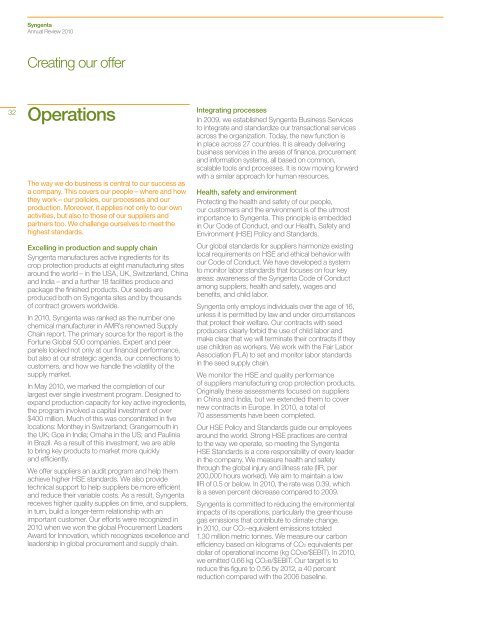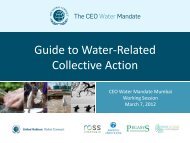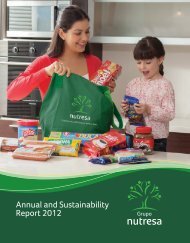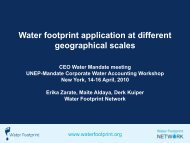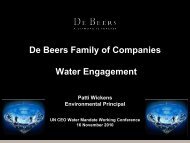Syngenta Annual Review 2010 - CEO Water Mandate
Syngenta Annual Review 2010 - CEO Water Mandate
Syngenta Annual Review 2010 - CEO Water Mandate
You also want an ePaper? Increase the reach of your titles
YUMPU automatically turns print PDFs into web optimized ePapers that Google loves.
<strong>Syngenta</strong><br />
<strong>Annual</strong> <strong>Review</strong> <strong>2010</strong><br />
Creating our offer<br />
32<br />
Operations<br />
The way we do business is central to our success as<br />
a company. This covers our people – where and how<br />
they work – our policies, our processes and our<br />
production. Moreover, it applies not only to our own<br />
activities, but also to those of our suppliers and<br />
partners too. We challenge ourselves to meet the<br />
highest standards.<br />
Excelling in production and supply chain<br />
<strong>Syngenta</strong> manufactures active ingredients for its<br />
crop protection products at eight manufacturing sites<br />
around the world – in the USA, UK, Switzerland, China<br />
and India – and a further 18 facilities produce and<br />
package the finished products. Our seeds are<br />
produced both on <strong>Syngenta</strong> sites and by thousands<br />
of contract growers worldwide.<br />
In <strong>2010</strong>, <strong>Syngenta</strong> was ranked as the number one<br />
chemical manufacturer in AMR’s renowned Supply<br />
Chain report. The primary source for the report is the<br />
Fortune Global 500 companies. Expert and peer<br />
panels looked not only at our financial performance,<br />
but also at our strategic agenda, our connections to<br />
customers, and how we handle the volatility of the<br />
supply market.<br />
In May <strong>2010</strong>, we marked the completion of our<br />
largest ever single investment program. Designed to<br />
expand production capacity for key active ingredients,<br />
the program involved a capital investment of over<br />
$400 million. Much of this was concentrated in five<br />
locations: Monthey in Switzerland; Grangemouth in<br />
the UK; Goa in India; Omaha in the US; and Paulinia<br />
in Brazil. As a result of this investment, we are able<br />
to bring key products to market more quickly<br />
and efficiently.<br />
We offer suppliers an audit program and help them<br />
achieve higher HSE standards. We also provide<br />
technical support to help suppliers be more efficient<br />
and reduce their variable costs. As a result, <strong>Syngenta</strong><br />
receives higher quality supplies on time, and suppliers,<br />
in turn, build a longer-term relationship with an<br />
important customer. Our efforts were recognized in<br />
<strong>2010</strong> when we won the global Procurement Leaders<br />
Award for Innovation, which recognizes excellence and<br />
leadership in global procurement and supply chain.<br />
Integrating processes<br />
In 2009, we established <strong>Syngenta</strong> Business Services<br />
to integrate and standardize our transactional services<br />
across the organization. Today, the new function is<br />
in place across 27 countries. It is already delivering<br />
business services in the areas of finance, procurement<br />
and information systems, all based on common,<br />
scalable tools and processes. It is now moving forward<br />
with a similar approach for human resources.<br />
Health, safety and environment<br />
Protecting the health and safety of our people,<br />
our customers and the environment is of the utmost<br />
importance to <strong>Syngenta</strong>. This principle is embedded<br />
in Our Code of Conduct, and our Health, Safety and<br />
Environment (HSE) Policy and Standards.<br />
Our global standards for suppliers harmonize existing<br />
local requirements on HSE and ethical behavior with<br />
our Code of Conduct. We have developed a system<br />
to monitor labor standards that focuses on four key<br />
areas: awareness of the <strong>Syngenta</strong> Code of Conduct<br />
among suppliers, health and safety, wages and<br />
benefits, and child labor.<br />
<strong>Syngenta</strong> only employs individuals over the age of 16,<br />
unless it is permitted by law and under circumstances<br />
that protect their welfare. Our contracts with seed<br />
producers clearly forbid the use of child labor and<br />
make clear that we will terminate their contracts if they<br />
use children as workers. We work with the Fair Labor<br />
Association (FLA) to set and monitor labor standards<br />
in the seed supply chain.<br />
We monitor the HSE and quality performance<br />
of suppliers manufacturing crop protection products.<br />
Originally these assessments focused on suppliers<br />
in China and India, but we extended them to cover<br />
new contracts in Europe. In <strong>2010</strong>, a total of<br />
70 assessments have been completed.<br />
Our HSE Policy and Standards guide our employees<br />
around the world. Strong HSE practices are central<br />
to the way we operate, so meeting the <strong>Syngenta</strong><br />
HSE Standards is a core responsibility of every leader<br />
in the company. We measure health and safety<br />
through the global injury and illness rate (IIR, per<br />
200,000 hours worked). We aim to maintain a low<br />
IIR of 0.5 or below. In <strong>2010</strong>, the rate was 0.39, which<br />
is a seven percent decrease compared to 2009.<br />
<strong>Syngenta</strong> is committed to reducing the environmental<br />
impacts of its operations, particularly the greenhouse<br />
gas emissions that contribute to climate change.<br />
In <strong>2010</strong>, our CO2-equivalent emissions totaled<br />
1.30 million metric tonnes. We measure our carbon<br />
efficiency based on kilograms of CO2 equivalents per<br />
dollar of operational income (kg CO2e/$EBIT). In <strong>2010</strong>,<br />
we emitted 0.66 kg CO2e/$EBIT. Our target is to<br />
reduce this figure to 0.56 by 2012, a 40 percent<br />
reduction compared with the 2006 baseline.


